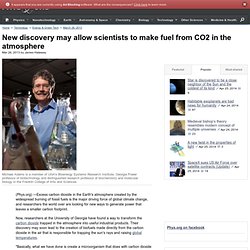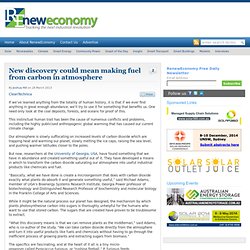

Ambient Electromagnetic Energy. (Before It's News) Georgia Tech graduate student Rushi Vyas (front) holds a prototype energy-scavenging device, while School of Electrical and Computer Engineering professor Manos Tentzeris displays a miniaturized flexible antenna that was inkjet-printed on paper and could be used for broadband energy scavenging.

Credit: Georgia Tech Photo: Gary Meek Researchers have discovered a way to capture and harness energy transmitted by such sources as radio and television transmitters, cell phone networks and satellite communications systems. By scavenging this ambient energy from the air around us, the technique could provide a new way to power networks of wireless sensors, microprocessors and communications chips. "There is a large amount of electromagnetic energy all around us, but nobody has been able to tap into it," said Manos Tentzeris, a professor in the Georgia Tech School of Electrical and Computer Engineering who is leading the research. Credit: Georgia Tech Photo: Gary Meek Source: Fuel from Atmospheric CO2. (Phys.org) —Excess carbon dioxide in the Earth's atmosphere created by the widespread burning of fossil fuels is the major driving force of global climate change, and researchers the world over are looking for new ways to generate power that leaves a smaller carbon footprint.

Now, researchers at the University of Georgia have found a way to transform the carbon dioxide trapped in the atmosphere into useful industrial products. Their discovery may soon lead to the creation of biofuels made directly from the carbon dioxide in the air that is responsible for trapping the sun's rays and raising global temperatures. During the process of photosynthesis, plants use sunlight to transform water and carbon dioxide into sugars that the plants use for energy, much like humans burn calories from food. These sugars can be fermented into fuels like ethanol, but it has proven extraordinarily difficult to efficiently extract the sugars, which are locked away inside the plant's complex cell walls. Atmospheric carbon dioxide. Researchers Discover That Fuel Can Be Made From Sunlight. Scientists have developed a reactor that mimics plants by turning sunlight into fuel.

This is another discovery that could be implemented on a mass scale simply by using the sun. Researchers at the California Institute of Technology have built a reactor with a quartz window that absorbs sunlight and acts as a concentration device to direct sunlight to a desired location. In the center of the reactor is something called oxide, which allows oxygen to exhale from its crystalline structure at high temperatures, and inhale oxygen back at lower temperatures. Specifically, the inhaled oxygen is stripped off of carbon dioxide (CO2) and/or water (H2O) gas molecules that are pumped into the reactor, producing carbon monoxide (CO) and/or hydrogen gas (H2).
H2 can be used to fuel hydrogen fuel cells; CO, combined with H2, can be used to create synthetic gas, or “syngas,” which is the precursor to liquid hydrocarbon fuels. Sources: New discovery could mean making fuel from carbon in atmosphere. CleanTechnica If we’ve learned anything from the totality of human history, it is that if we ever find anything in great enough abundance, we’ll try to use it for something that benefits us.

One need only look at the coal deposits, forests, and oceans for proof of this. This instinctual human trait has been the cause of numerous conflicts and problems, including the highly publicised anthropogenic global warming that has caused our current climate change. Our atmosphere is slowly suffocating on increased levels of carbon dioxide which are trapping heat and warming our planet, slowly melting the ice caps, raising the sea level, and pushing warmer latitudes closer to the poles.
But now, researchers at the University of Georgia, USA, have found something that we have in abundance and created something useful out of it. “What this discovery means is that we can remove plants as the middleman,” said Adams, who is co-author of the study. Exclusive: Pioneering scientists turn fresh air into petrol in massive boost in fight against energy crisis - Home News - UK. Air Fuel Synthesis in Stockton-on-Tees has produced five litres of petrol since August when it switched on a small refinery that manufactures gasoline from carbon dioxide and water vapour.

The company hopes that within two years it will build a larger, commercial-scale plant capable of producing a ton of petrol a day. It also plans to produce green aviation fuel to make airline travel more carbon-neutral. Tim Fox, head of energy and the environment at the Institution of Mechanical Engineers in London, said: "It sounds too good to be true, but it is true. They are doing it and I've been up there myself and seen it.
The innovation is that they have made it happen as a process. Although the process is still in the early developmental stages and needs to take electricity from the national grid to work, the company believes it will eventually be possible to use power from renewable sources such as wind farms or tidal barrages.